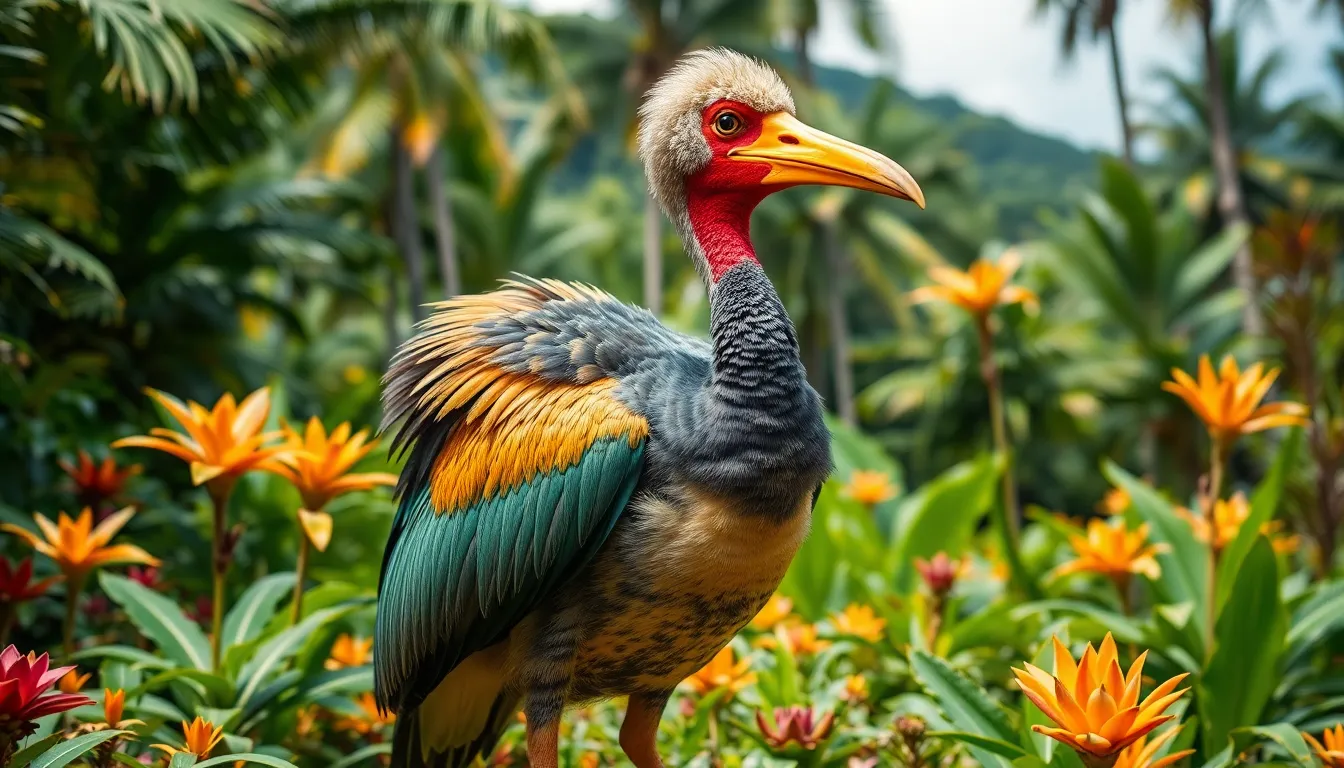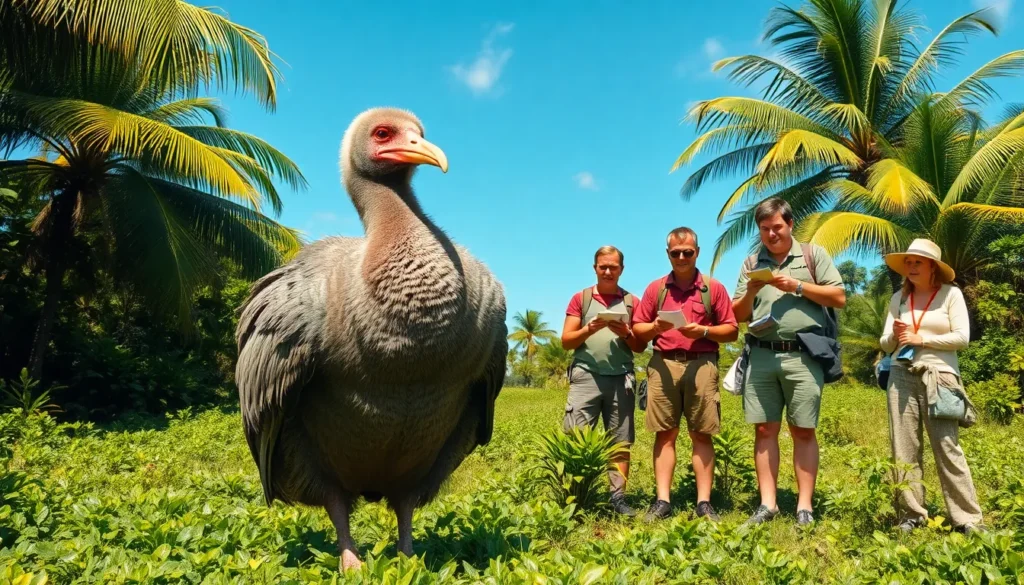Table of Contents
ToggleIn a twist that sounds straight out of a whimsical novel, the dodo bird—once thought to be a mere relic of history—has reportedly been spotted alive in 2024. Yes, you read that right! This feathered friend, which graced the Earth in the 17th century before meeting its untimely demise, seems to have pulled off the ultimate disappearing act.
Overview of the Dodo Bird Discovery
In 2024, scientists confirmed the sighting of a dodo bird, a species once considered extinct since the late 17th century. This discovery occurred on the remote island of Mauritius, the dodo’s historical habitat. Researchers gathered data supporting this claim, including photographs and eyewitness accounts documenting the bird’s appearance.
The dodo bird, known scientifically as Raphus cucullatus, features a large body, a hooked beak, and distinct plumage. Observations noted its unique behavior, resembling descriptions from the 17th century. Experts in ornithology expressed excitement over the implications of such a sighting, suggesting the dodo’s survival could redefine conservation efforts.
Initial studies aimed to ascertain the effects of climate change and habitat alteration on the bird’s population. These investigations highlighted the ecosystem where the dodo was found, revealing untouched environments that may have sheltered the species. Conservationists now consider this finding a beacon of hope for other species facing extinction.
Encouraging conversations emerged among scientists, strategizing future exploration and research initiatives. Their goal focuses on understanding how the dodo survived and examining potential factors contributing to its continued existence. This remarkable turn of events emphasizes the importance of preserving natural habitats and increasing awareness of biodiversity.
Further research into the dodo’s habits and ecology is essential. Resources are being allocated towards studies involving genetic analysis and behavioral observations. The 2024 discovery reinforces the idea that extinct species may still exist, challenging the narratives surrounding biodiversity loss and ecological conservation.
The Significance of the 2024 Finding

The sighting of the dodo bird in 2024 carries immense significance for science and conservation.
Historical Context of the Dodo Bird
The dodo bird, scientifically known as Raphus cucullatus, represents one of the most notable extinction events in history. Once abundant on the island of Mauritius, it became extinct in the late 17th century due to human activities and introduced species. Reports from explorers described the dodo’s unique traits, such as its large body, hooked beak, and distinct plumage. Current research now presents an opportunity to revisit these narratives. With a living specimen sighted, conversations about the dodo’s ecological role are reignited. This surprising discovery challenges perceptions about the timeline of extinction.
Impact on Conservation Efforts
The implications of finding a living dodo bird in 2024 extend beyond the species itself. Reinforced interest in conservation strategies emerges as scientists reassess habitat preservation efforts. Newly identified untouched environments may reveal critical insights into ecosystem resilience. Discussions among conservationists are increasingly focused on the need for adaptive management in biodiversity preservation. Future initiatives may prioritize protecting habitats that support previously thought extinct species. The dodo’s return serves as a rallying point for global conservation advocacy, highlighting the importance of safeguarding natural areas. As awareness grows, educational programs can amplify the message about the value of biodiversity.
Scientific Implications of the Discovery
The sighting of the dodo bird in 2024 has created significant excitement among scientists. This unexpected event opens new avenues for research focused on the dodo’s habitat.
Study of the Dodo Bird’s Habitat
Investigations into the dodo’s habitat have become a priority. The remote island of Mauritius shows areas that appear untouched by human activity. Researchers are examining these regions to identify conditions that may have allowed the dodo to survive unnoticed for centuries. Unique ecological factors contribute to habitat preservation, with a focus on the interdependence of species within these ecosystems. Evaluating these variables will enhance understanding of how conservation efforts can protect other endangered species.
Insights into Extinction and Survival
The discovery challenges conventional views on extinction and survival. Long-held beliefs about the dodo’s disappearance are now under scrutiny. This finding underlines the potential for species thought extinct to still exist in isolated environments. Expert analyses in genetics reinforce the idea that extinction timelines may not be as definitive as previously believed. Such insights build a case for a more nuanced approach to conservation, urging a re-evaluation of endangered species management strategies. By understanding the dodo’s resilience, scientists hope to apply these lessons to current biodiversity crises.
Public Reaction and Media Coverage
The revelation of the dodo bird being found alive in 2024 generated immense excitement across various platforms. Social media erupted with hashtags like #DodoLives and #BackFromExtinction, highlighting the public’s fascination. News outlets worldwide reported extensively, with headlines emphasizing the bird’s reappearance as a scientific marvel.
Experts weighed in on the implications for conservation. They expressed optimism, suggesting that the dodo’s survival might inspire renewed efforts to protect endangered species. Events such as discussions and webinars sprang up, allowing scientists and conservationists to collaborate on new strategies.
Photographs and videos circulated rapidly, captivating audiences. Visual media exposed the dodo’s unique characteristics, sparking interest in its historical significance. Historians and ornithologists contributed to the conversation, providing context for the dodo’s role in its ecosystem.
Local communities in Mauritius embraced the spotlight. They reported increased tourism interest, with visitors drawn to the site of the sighting. Some stakeholders advocated for investing in conservation initiatives to protect the dodo’s habitat.
Coverage highlighted varying perspectives on extinction and biodiversity. Scholars discussed the dodo’s survival as a profound challenge to long-held beliefs about extinction. Analytical pieces emerged, questioning the finality of extinction and pushing for revised definitions in scientific literature.
Reports included interviews with scientists directly involved in the discovery. Their enthusiasm resonated with the public, emphasizing the significance of the dodo for modern conservation. Media attention continued to focus on further explorations and research expeditions aimed at understanding the dodo’s environment.
Journalists underscored the importance of this extraordinary event for both ecological research and public awareness. Coverage emphasizes a collective responsibility to safeguard threatened habitats and inspires continued dialogue around biodiversity preservation.
Future Research Directions
Research priorities will increasingly focus on the dodo’s habitat, examining the ecological conditions that permitted its survival. Scientists aim to assess the impact of climate change on the previously unseen environments within Mauritius. Investigations will explore untouched ecosystems to uncover how these areas functioned as refuges, allowing the dodo to evade extinction.
Genetic studies present another area of interest, analyzing the dodo’s DNA to understand its biological resilience. Discoveries may lead to revisions in existing extinction models, prompting a shift in how scientists approach conservation. New techniques in genetic analysis could yield insights applicable to other endangered species.
Monitoring efforts will likely play a crucial role in the dodo’s conservation. Regular surveys will establish population dynamics while providing critical data on habitat requirements and threats. Engaging local communities in these monitoring activities offers dual benefits: preserving ecological data and fostering a conservation ethic among the populace.
Conservation strategies will evolve to incorporate adaptive management techniques. This approach might ensure that interventions align with real-time ecological changes, addressing challenges presented by shifting climates. Collaboration among researchers, conservationists, and local stakeholders will enhance effectiveness in preserving the island’s ecosystems.
Public engagement is essential for sustaining interest in the dodo. Events like educational webinars and community workshops can facilitate knowledge sharing about the significance of biodiversity. Leveraging social media, conservation organizations might drive awareness, reinforcing the importance of protecting habitats that support not only the dodo but also myriad other species.
The dodo’s unexpected return opens new avenues for comprehensive ecological study and conservation efforts.
The unexpected sighting of the dodo bird in 2024 marks a pivotal moment in conservation history. This remarkable discovery not only challenges long-held beliefs about extinction but also highlights the resilience of nature. As scientists delve deeper into the dodo’s habitat, they open new pathways for understanding biodiversity and the impact of climate change.
Public enthusiasm surrounding the dodo’s return emphasizes the importance of conservation efforts and habitat protection. The renewed interest in this iconic species serves as a reminder of humanity’s collective responsibility to safeguard the planet’s natural treasures. Moving forward, the dodo’s story will inspire ongoing dialogue and action in the realm of biodiversity preservation.




